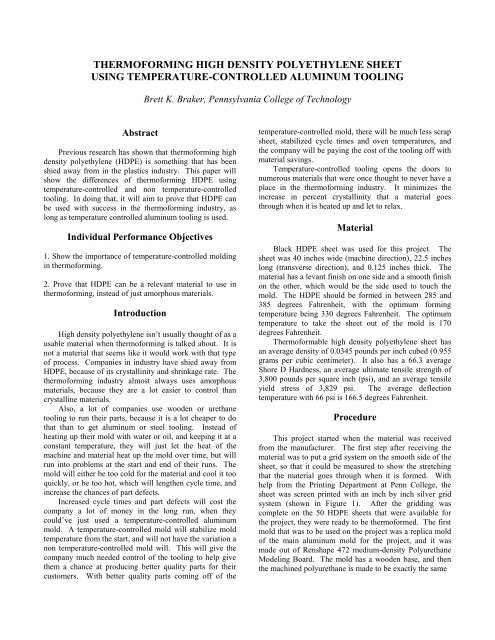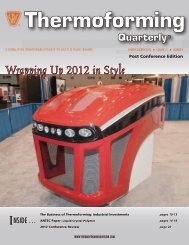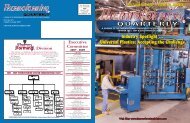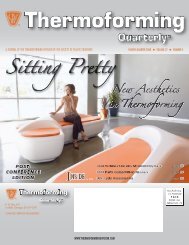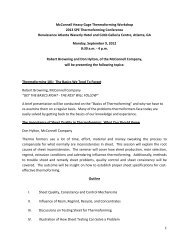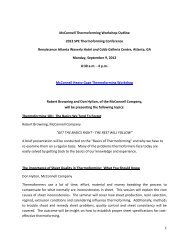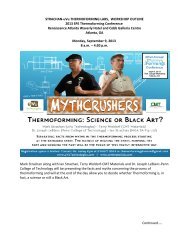thermoforming high density polyethylene sheet using - SPE ...
thermoforming high density polyethylene sheet using - SPE ...
thermoforming high density polyethylene sheet using - SPE ...
You also want an ePaper? Increase the reach of your titles
YUMPU automatically turns print PDFs into web optimized ePapers that Google loves.
THERMOFORMING HIGH DENSITY POLYETHYLENE SHEETUSING TEMPERATURE-CONTROLLED ALUMINUM TOOLINGBrett K. Braker, Pennsylvania College of TechnologyAbstractPrevious research has shown that <strong>thermoforming</strong> <strong>high</strong><strong>density</strong> <strong>polyethylene</strong> (HDPE) is something that has beenshied away from in the plastics industry. This paper willshow the differences of <strong>thermoforming</strong> HDPE <strong>using</strong>temperature-controlled and non temperature-controlledtooling. In doing that, it will aim to prove that HDPE canbe used with success in the <strong>thermoforming</strong> industry, aslong as temperature controlled aluminum tooling is used.Individual Performance Objectives1. Show the importance of temperature-controlled moldingin <strong>thermoforming</strong>.2. Prove that HDPE can be a relevant material to use in<strong>thermoforming</strong>, instead of just amorphous materials.IntroductionHigh <strong>density</strong> <strong>polyethylene</strong> isn’t usually thought of as ausable material when <strong>thermoforming</strong> is talked about. It isnot a material that seems like it would work with that typeof process. Companies in industry have shied away fromHDPE, because of its crystallinity and shrinkage rate. The<strong>thermoforming</strong> industry almost always uses amorphousmaterials, because they are a lot easier to control thancrystalline materials.Also, a lot of companies use wooden or urethanetooling to run their parts, because it is a lot cheaper to dothat than to get aluminum or steel tooling. Instead ofheating up their mold with water or oil, and keeping it at aconstant temperature, they will just let the heat of themachine and material heat up the mold over time, but willrun into problems at the start and end of their runs. Themold will either be too cold for the material and cool it tooquickly, or be too hot, which will lengthen cycle time, andincrease the chances of part defects.Increased cycle times and part defects will cost thecompany a lot of money in the long run, when theycould’ve just used a temperature-controlled aluminummold. A temperature-controlled mold will stabilize moldtemperature from the start, and will not have the variation anon temperature-controlled mold will. This will give thecompany much needed control of the tooling to help givethem a chance at producing better quality parts for theircustomers. With better quality parts coming off of thetemperature-controlled mold, there will be much less scrap<strong>sheet</strong>, stabilized cycle times and oven temperatures, andthe company will be paying the cost of the tooling off withmaterial savings.Temperature-controlled tooling opens the doors tonumerous materials that were once thought to never have aplace in the <strong>thermoforming</strong> industry. It minimizes theincrease in percent crystallinity that a material goesthrough when it is heated up and let to relax.MaterialBlack HDPE <strong>sheet</strong> was used for this project. The<strong>sheet</strong> was 40 inches wide (machine direction), 22.5 incheslong (transverse direction), and 0.125 inches thick. Thematerial has a levant finish on one side and a smooth finishon the other, which would be the side used to touch themold. The HDPE should be formed in between 285 and385 degrees Fahrenheit, with the optimum formingtemperature being 330 degrees Fahrenheit. The optimumtemperature to take the <strong>sheet</strong> out of the mold is 170degrees Fahrenheit.Thermoformable <strong>high</strong> <strong>density</strong> <strong>polyethylene</strong> <strong>sheet</strong> hasan average <strong>density</strong> of 0.0345 pounds per inch cubed (0.955grams per cubic centimeter). It also has a 66.3 averageShore D Hardness, an average ultimate tensile strength of3,800 pounds per square inch (psi), and an average tensileyield stress of 3,829 psi. The average deflectiontemperature with 66 psi is 166.5 degrees Fahrenheit.ProcedureThis project started when the material was receivedfrom the manufacturer. The first step after receiving thematerial was to put a grid system on the smooth side of the<strong>sheet</strong>, so that it could be measured to show the stretchingthat the material goes through when it is formed. Withhelp from the Printing Department at Penn College, the<strong>sheet</strong> was screen printed with an inch by inch silver gridsystem (shown in Figure 1). After the gridding wascomplete on the 50 HDPE <strong>sheet</strong>s that were available forthe project, they were ready to be thermoformed. The firstmold that was to be used on the project was a replica moldof the main aluminum mold for the project, and it wasmade out of Renshape 472 medium-<strong>density</strong> PolyurethaneModeling Board. The mold has a wooden base, and thenthe machined polyurethane is made to be exactly the same
Figure 1 (gridding system on <strong>sheet</strong> after being formed)dimensionally as the aluminum mold, which in relation tothe material, is 15.25 inches long, 33.125 inches wide, and4.2 inches <strong>high</strong>.The mold was first set on the lower platen (shown inFigure 2) of the MAAC Thermoformer that was used onthe project. The first set of parts that were made on themachine was to try and help set up a process that wouldproduce a quality part, so that a production-style run couldbe started. After a few parts were formed, it was easilydetermined that the mold should be hung from the topplaten rather than the bottom platen.If the properties are compromised, the part has a possibilityof failing once it gets out to its customer and starts beingused. Hanging the mold from the top platen eliminates thisfrom happening to the material. With the mold comingfrom the top of the sagging material, there is only onestretch on the material, which is in the same direction ofthe sag, and then the vacuum created by the seal betweenmaterial and mold sucks the material back to the shape ofthe mold. This type of molding minimizes the stress on thematerial and theoretically eliminates the extra physicalproperty damage done by double stretching with molds seton the bottom platen.Figure 3 (Renshape mold on top platen)Figure 2 (Renshape mold on bottom platen)The mold was switched from being set on the bottomplaten to being hung from the top platen, because the sag inthe pliable material coming from the oven coinciding withthe top of the cool mold would cause a build-up of materialin the four corners where the material would drape over theside of the mold. Switching to the top platen (shown inFigure 3) would eliminate the build-up of material in thecorners, and create a better quality part.Also by switching to the top platen, counter materialsag stretching was eliminated. When a material is run in a<strong>thermoforming</strong> machine with the mold set on the bottomplaten, the sag of the material as it comes out of the oven ismet by the mold coming up into the pliable <strong>sheet</strong> and goingthrough it to help create a seal to be able to vacuum the<strong>sheet</strong> around the dimensions of the mold. Thisphenomenon stretches the material twice, which couldlessen some of the material’s important physical properties.After the urethane mold was hung from the top platen,the machine settings were altered so that they were theexact same as the bottom platen settings and it was timeagain to try and find the correct settings and cycle toproduce quality parts repeatedly. Once they were found, aproduction-style run could be performed.A few problems were run into when trying to find the“perfect” cycle. The first problem was that the rails thathold the <strong>sheet</strong> in place were set too close to the mold andthe mold was going too far through the rails. This causedthe back of the <strong>sheet</strong> to rip out completely. After this, therails were moved out to about one-half inch from the moldand the mold was programmed so that it didn’t go throughthe rails as far. The top of the mold was then set to godown 5.5 inches from the <strong>sheet</strong> in the rails. The <strong>sheet</strong>didn’t rip completely when the mold came down throughit, but it did leave a few small tear spots, which were a signof the side of the <strong>sheet</strong> closest to the oven being too hotwhen it came out to be formed (shown in Figure 4). Thisproblem was fixed by lowering the oven percentages in theback of the oven so that part of the <strong>sheet</strong> wouldn’t be ashot as it exited the oven. After the cycle was finalized, theproduction-style run was ready to be started. Aproduction-style run is basically just a certain number of<strong>sheet</strong>s run one right after another. This production run wasset for 10 <strong>sheet</strong>s, and there were a number of variables thatwere measured related to the machine during the
production run. They were: temperature of the front of themold, the top of the mold,Figure 4 (Tears in back of formed <strong>sheet</strong>)and the back of the mold (all of which were taken rightbefore the next <strong>sheet</strong> in the run was loaded in the rails),<strong>sheet</strong> temperature as it came out of the oven right beforeforming, and temperature of the <strong>sheet</strong> after the rails openedafter cooling and the formed part was ready to be taken outof the machine. Room temperature and humidity were alsomeasured before every <strong>sheet</strong> was loaded.After the formed <strong>sheet</strong> came out of the mold, it was setinto the measuring jig that was made for the dimensions ofwhat the <strong>sheet</strong> should be as it comes off the mold. Thealuminum jig (shown in Figure 5) is 33.500 inches wideand 15.875 inches long. The <strong>sheet</strong> was placed in the jig theexact same way every time, and measured in 10 differentplaces along the lengths and widths of the part (shown inFigure 6) <strong>using</strong> dial calipers set at the edge of the jig andbeing extended into the formed <strong>sheet</strong>.Figure 5 (HDPE <strong>sheet</strong> in aluminum jig)Also shown in Figure 5 is how thicknessmeasurements were taken on each of the <strong>sheet</strong>s after theyhad been measured <strong>using</strong> the jig. A drill and hole sawattachment were used to cut one-inch holes in the top,front, left, back, and right sides of the <strong>sheet</strong>. The discs thatwere produced were then measured for thickness. Figure 5also shows that the holes were drilled in the left side ofeach side immediately after the <strong>sheet</strong> was taken out of themachine. Measurements taken 24 or more hours later weredrilled out of the right side of each side.Also shown in Figure 5 is how the heightmeasurement was taken for each part after the 10 jigmeasurements were taken. Two aluminum blocks wereplaced on the long sides of the aluminum jig, and analuminum meter stick was placed on top of the blocks.The dial calipers were then extended from the top of themeter stick to the top of the formed <strong>sheet</strong>. That numberwas then plugged into a formula (5.5625 – x = height) toobtain the actual height of the part. The number 5.5625comes from the jig thickness, aluminum block height, andmeter stick height.After all of the measurements were taken, they couldbe plugged into formulas that would give the formed <strong>sheet</strong>lengths and widths at the given measurement points. Theoriginal measurement points and their correspondingformula labels are shown in Figure 6.BL 8(Y1) 7(Y2) 6(Y3)9 (X2) MD5 (X2)10 (X1) TD4 (X1)FL 1(Y1) 2(Y2) 3(Y3)Figure 6 (Measurement points and formula labels)The formulas were calculated by taking the original jigY (machine) direction (15.875 inches) or the original jig X(transverse) direction (33.500 inches) and subtracting thetwo measurement points that go together (1-8, 3-6, 5-9,etc.). An example for the Y1 measurement would be15.875 inches minus the combination of measurements 1and 8 (0.1025 and 0.4865), measured with the dial calipers,which would equal out to a Y1 length of 15.2860 inches.The caliper measurements help show the warpage of theformed part and the formulas for the length and width helpshow the overall shrinkage.After the production style run was completed with theRenshape urethane mold, the aluminum mold needed to beprepared so that it too could be hung in the machine andused for a production-style run to compare with theproduction run performed with the Renshape mold. Thealuminum mold was sealed and then was switched out withthe Renshape mold so that a production-style run could beperformed. The aluminum mold has water lines inside ofit, so a circulator was used to send hot water into the moldto control the temperature of the <strong>sheet</strong>s, so that therewouldn’t be an increase in mold temperature as there wasin the Renshape production run. All of the samemeasurements were performed during the aluminumproduction-style run, with the only additions being thecirculator temperature and the inlet and outlet temperaturesto and from the mold and circulator.
A Design of Experiment (DOE) was also performedfor the project <strong>using</strong> the temperature-controlled aluminummold. The main purpose of the DOE was to show ifextreme <strong>high</strong> and low values were mixed and used in acycle could produce quality parts like the production-stylerun. The three factors used in the DOE were cooling time,circulator temperature, and infrared (I.R.) eye temperature.The infrared eye is a laser that measures the temperature ofthe <strong>sheet</strong> in the oven. Figure 7 shows all the different setupsran for the DOE. The MAAC <strong>thermoforming</strong> machineallows for either a time or temperature-based oven time.The cycle that was used in this project was temperaturebased.The <strong>high</strong> and low values for cooling time were 150and 90 seconds, respectively. The <strong>high</strong> and low values forcirculator temperature were 205 and 170 degreesFahrenheit, respectively, and the <strong>high</strong> and low values forI.R. eye temperature were 330 and 400 degrees Fahrenheit,respectively.Run Cooling TimeCirculator I.R. EyeTemp Temp1 - - -2 - - +3 - + -4 - + +5 + - -6 + + -7 + - +8 + + +Figure 7 (DOE Table)Results and DiscussionThe first results that were obtained were from theproduction-style run of the Renshape (REN) mold. Whenthe machine was first heated up, five parts were run tosolidify the cycle so there wouldn’t be a lot of variationduring the production run. Since the five parts were ran,the mold already started to heat up. Appendix A shows thetemperatures measured during the production style run.The graph shows that every measured mold temperatureincreased by at least 10 percent and up to 25 percent, andthe forming temperature increased by 6 percent withoutany parameters being changed. The ejection temperaturealso increased by 12 percent in 7 runs until cooling timewas increased to help make the parts easier to handle out ofthe mold.The measurements that were taken on the REN moldparts right after forming and 72 hours after forming areshown in Figure 8. The most noticeable thing about theREN mold measurements was how much the part shrank inonly three days. The length of the formed <strong>sheet</strong> shrankabout one-half inch in three days and the width shrankabout one-quarter inch in three days. The standarddeviation of the length averages about 80 thousandths of aninch and the width’s standard deviation averages 64thousandths of an inch. The height shrank about onesixteenthof an inch in three days.The thickness of the <strong>sheet</strong> also shrank dramaticallyafter three days. The front thickness shrank about 12percent, the right shrank 23 percent, the back shrank 15percent, the left shrank 27 percent, and the top shrank 6percent. The standard deviation for the thicknessesaverages around 8 thousandths of an inch right afterforming, but only around 5 thousandths of an inch after 72hours. This shows that the thicknesses vary a lot right offof the mold, but get to a more stable state after they shrink.REN 2 mins 72 hrs 2 mins 72 hrsDimensions Average Average St. Dev. St. Dev.Y1 15.2772 14.7679 0.0737 0.0817Y2 15.2703 14.6292 0.0916 0.1319Y3 15.2146 14.6189 0.1027 0.1786X1 32.8077 32.5823 0.0680 0.0540X2 32.7825 32.5545 0.0604 0.0547Z 3.6531 3.5861 0.1874 0.0854Thickness Average Average St. Dev. St. Dev.Front 0.0728 0.0640 0.0066 0.0063Right 0.0699 0.0541 0.0072 0.0036Back 0.0693 0.0590 0.0086 0.0056Left 0.0733 0.0536 0.0105 0.0034Top 0.1280 0.1207 0.0068 0.0037Figure 8 (REN mold measurements)Aluminum Al 2 mins Al 72 hrs Al 2 mins Al 72 hrsDimensions Average Average St. Dev. St. Dev.Y1 15.1864 15.0772 0.0532 0.0629Y2 15.3429 15.2224 0.0556 0.0498Y3 15.2405 15.1412 0.0387 0.0494X1 32.7307 32.4864 0.0815 0.0799X2 32.6969 32.5176 0.0234 0.0627Z 3.5513 3.5266 0.0566 0.0451Thickness Average Average St. Dev. St. Dev.Front 0.0939 0.0903 0.0021 0.0047Right 0.0838 0.0807 0.0064 0.0054Back 0.0846 0.0918 0.0028 0.0055Left 0.0810 0.0835 0.0021 0.0044Top 0.1029 0.1083 0.0017 0.0055Figure 9 (Aluminum mold measurements)After all of the data was collected and measured forthe urethane mold, the temperature-controlled aluminummold was ready to be switched out. Appendix B shows theforming temperatures during the production-style run <strong>using</strong>the aluminum mold. This mold required a few moremeasurements: rail temperature, circulator temperature,and inlet and outlet temperature of the circulator.The production-style run was started with a 100second cooling time and a 370 degree Fahrenheit I.R. eye.Before <strong>sheet</strong> 4 was loaded, the cooling time was extendedto 120 seconds, because the <strong>sheet</strong> was consistently comingout at around 200 degrees. It came down to about 190degrees, and then before <strong>sheet</strong> 5 was loaded, the cooling
was increased to 150 seconds and the I.R. eye was changedto 360 degrees Fahrenheit, because at 370 degrees the <strong>sheet</strong>was coming out in a consistent pattern of 343 and 330degrees Fahrenheit. Before <strong>sheet</strong>s 7, 8, and 9 were loaded,the cooling time was decreased to 130 seconds, 120seconds, and 110 seconds respectively to see what kind ofeffect it would have on the ejection temperature. This canalso be seen in Appendix B. As seen on Appendix B, thetop of the mold barely changed at all during the productionrun, while the front and back of the mold increasedslightly, with the back increasing the most, because it isclosest to the oven (which reaches upwards of 700 degreesFahrenheit). The rails, circulator, and inlet and outlettemperatures all stayed virtually the same throughout theproduction run.Appendix C-1 shows the part lengths after 72 hoursover the course of the production run. The REN moldparts have a downward sloping trend for the lengths. Thetemperature-controlled aluminum mold parts basicallystayed the same overall, but have a slight upwardsundulation in the middle of the run.Appendix C-2 shows the part widths after 72 hoursover the course of the production run. The REN mold partwidths both have downward sloping trends, while thetemperature-controlled aluminum mold part widths haveone upward and one slightly downward sloping trend. Thisshows that even though the aluminum has differing trends,it is still closer to staying the same than the REN mold partwidths.The measurements of the formed <strong>sheet</strong>s (shown inFigure 9) showed much better results than the REN mold.While the REN mold widths shrank an average of one-halfinch in 3days, the aluminum mold widths only shrankabout one-tenth of an inch. The REN mold and aluminummold lengths both shrank about one-quarter inch. TheREN mold height shrank about one-sixteenth of an inchand the aluminum mold shrank less than one-thirty second.The aluminum thicknesses only changed at most 8.5percent, and averaged about 3.5 percent, while the RENmold thicknesses changed up to 27 percent and averaged16.5 percent.OVERALL SHRINKAGEREN 72 hrs Aluminum 72 hrsWidth 3.816% Width 0.719%Length 0.691% Length 0.647%Height 1.836% Height 0.696%Figure 10 (Overall Shrinkage)Figure 10 shows the overall shrinkage percentages forthe REN and aluminum mold. The REN mold widthsshrank over 5 times more than the aluminum, the lengthsshrank only one-half percent more, and the heights shrankover 3 times more than the aluminum.Warpage was also a key factor in the REN mold partsafter 72 hours (shown in Figure 11). These measurementscome directly from the aluminum jig, and show thedifference from the edge of the jig to the edge of the part.Each formed <strong>sheet</strong> that was brought off of thethermoformer and placed in the jig was pushed in thebottom right hand corner (in between measurement point 3and 4 as seen in Figure 6. Points 1, 2, and 3 made up thefront of the part. The REN mold seems to be better on thefront as it only changed about 34 thousandths while thealuminum changed 100 thousandths from point 1 to 2, butthat is the only instance of the REN being slightly betterthan the aluminum. Points 4 and 5 make up the right sideof the part, and the warpage was about six thousandths forboth the REN and aluminum mold.Warpage REN 72hrs Al 72hrs REN 72hrs Al 72hrsMeasurement Pt. Average Average St. Dev. St. Dev.1 0.2195 0.2134 0.0551 0.06872 0.2342 0.1188 0.0719 0.01313 0.2000 0.1339 0.0481 0.01924 0.2427 0.1639 0.0281 0.06865 0.2485 0.1583 0.0394 0.02786 1.0562 0.5999 0.1765 0.05387 1.0117 0.5339 0.1038 0.05148 0.8877 0.5845 0.0681 0.06099 0.6971 0.8242 0.0510 0.045410 0.6751 0.8498 0.0659 0.0605Figure 11 (Warpage measurements)The back is where the REN mold really warped. Itvaried about 75 thousandths where the aluminum moldonly varied about 65 thousandths. The left sides of theparts both varied about 20 thousandths. The standarddeviation for the REN mold show how much the warpagevaried on any one part. The front varied an average of 60thousandths on the REN mold and only about 40thousandths on the aluminum. The right sides were aboutthe same, with the aluminum having a slightly <strong>high</strong>erstandard deviation. The back of the REN mold partsvaried an average of 110 thousandths of an inch, while thealuminum only varied an average of 53 thousandths of aninch. The left sides of the REN mold parts varied anaverage of 58 thousandths, while the aluminum only variedan average of 52 thousandths. All these averages showthat the REN mold was much more unpredictable when itwas measured in the jig, because every part shrank andwarped differently, while the aluminum mold was muchmore consistent.The grid that was placed on the bottom of the <strong>sheet</strong>swas to show stretching in the machine and transversedirection. The grid on the Renshape mold expanded anaverage of 10 thousandths of an inch on the top of the moldin the machine direction and shrank an average of 20thousandths in the transverse direction. On the drawn partof the <strong>sheet</strong>, the material expanded an average of 1.500inches over the original inch in the machine direction andshrank an average of 25 thousandths in the transversedirection. The aluminum mold expanded an average of100 thousandths in the machine direction and 120
thousandths in the transverse direction on the top of thepart. On the drawn section of the part, the materialexpanded an additional inch in the machine direction andshrank an average of 20 thousandths in the transversedirection. All grid measurements were taken after 72hours. These measurements show that the temperaturecontrolledaluminum mold parts held their dimensions a lotmore than the Renshape mold parts, as the Renshape moldparts stretched and then shrank back down below theoriginal grid measurements after 72 hours.The Design of Experiment results showed that only acouple parts off of the aluminum temperature-controlledmold would be deemed quality. Run 1 with all the lowsettings, Run 3 with just a <strong>high</strong> circulator temperature, Run5 especially with just a <strong>high</strong> cooling time, and Run 6 with<strong>high</strong> cooling time and circulator temperature, all produceda part that was too cold when it was ejected. The top ofthe part stuck to the top of the mold, and permanentlydeformed the part by stretching it (shown in Figure 1).Run 2 with just a <strong>high</strong> I.R. eye temperature and Run 7 witha <strong>high</strong> I.R. eye and <strong>high</strong> cooling time, produced full partsthat ended up with a lot of warpage. Run 4 with a <strong>high</strong>circulator temperature and <strong>high</strong> I.R. eye temperatureproduced a full part that only exhibited a small amount ofwarpage, and Run 8, which had all <strong>high</strong> settings, producedthe best part of the DOE. This shows that the cycle thatwas set up for the production run is the best for thismaterial.Tensile tests were run on a number of the parts, withsamples being cut out of the front, back, left, and rightportions of the formed <strong>sheet</strong>. The results are shown inAppendix D. Unfortunately, the data that was collectedfrom the temperature-controlled aluminum tool parts wastoo random to determine whether one mold producedtougher parts than the other. Overall, the results looksimilar. The yield and maximum stresses, yield andmaximum elongation percentages, and maximum energywere all similar. The modulus measurements from theparts of the temperature-controlled aluminum mold werevery random and ranged from 3410 to 1.2 million, so itwas deemed irrelevant for the comparison.ConclusionOverall, the temperature-controlled aluminum moldshowed a much more consistent process than the Renshapemold did. It shrank less, warped less, and had a much<strong>high</strong>er dimensional stability. With that, this project provesthat there is a huge importance in temperature-controlledaluminum tooling in the <strong>thermoforming</strong> industry. This alsoshows that HDPE can be a relevant material in the<strong>thermoforming</strong> industry, instead of just amorphouspolymers. In conclusion, if a company wants to run acrystalline material that has a <strong>high</strong> shrinkage rate, then theyneed to use a temperature-controlled aluminum tool if theywant to continuously make quality parts.References1. Defosse, Matthew. "Thermoforming." ModernPlastics Worldwide World Encyclopedia2006. Los Angeles, CA: CanonCommunications, 2006. 106. Print.2. Harper, Charles A. Handbook of PlasticProcesses. Hoboken, NJ: Wiley-Interscience,2006. Print.3. Illig, Adolf, and PeterSchwarzmann. Thermoforming: A PracticalGuide. Munich: Hanser, 2001. Print.4. Peacock, Andrew J. Handbook of Polyethylene:Structures, Properties, and Applications.New York: Marcel Dekker, 2000. Print.5. "Sheet/Thermoforming Grade HDPE."www.matweb.com. Material Property Data.Web..AcknowledgementsJohn Bartolomucci, Pennsylvania College of TechnologyPatrick Bundra, Pennsylvania College of TechnologyTodd Chrismer, McClarin PlasticsTodd Kennedy, McClarin PlasticsRoger Kipp, McClarin PlasticsAaron Lapinski, Pennsylvania College of TechnologyGary McQuay, Plastics Manufacturing Center
Appendices
Part Length (in)Part Width (in)C-1: 72hr Part Length15.415.215.014.814.614.414.21 2 3 4 5 6 7 8 9 10REN Y1REN Y2REN Y3Al Y1Al Y2Al Y3Part NumberC-2: 72hr Part Width32.67532.62532.57532.52532.47532.42532.3751 2 3 4 5 6 7 8 9 10Part NumberREN X1REN X2Al X1Al X2Linear (REN X1)Linear (REN X2)Linear (Al X1)Linear (Al X2)D: TENSILE TESTINGType Yield Stress (psi) Max Stress (psi) Yield Elongation (%) Break Stress (psi) Modulus (psi) Max Energy (in*lb/in 3 ) Max Elongation (%) TE Auto (%)REN front 2830.00 2830.00 14.23 1157.23 53133.33 275.33 13.79 664.00Al front 2610.00 2610.00 13.74 760.50 514600.00 276.50 13.47 270.60REN back 2860.00 2860.00 13.72 1142.50 65250.00 278.75 12.88 486.25Al back 3086.67 3086.67 14.78 806.20 456900.00 351.67 14.40 249.33REN left 2835.00 2835.00 12.82 2169.67 42125.00 310.25 15.69 853.00Al left 1809.67 1813.33 17.89 899.33 19570.00 198.00 16.83 1040.67REN right 2765.00 2765.00 16.06 2109.25 31950.00 283.00 15.53 1032.50Al right 2776.67 2783.33 17.43 2032.33 131100.00 313.67 16.73 1039.00


